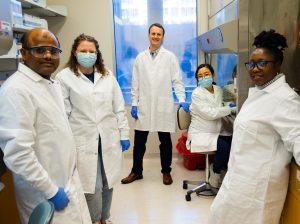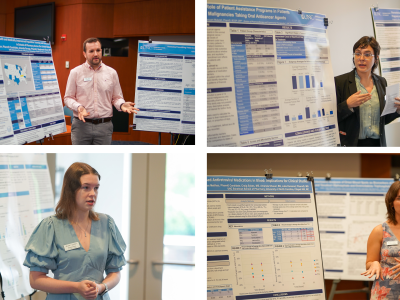May 15, 2023

In a full-circle moment, brain cancer survivor Andrew Satterlee, Ph.D. is one step closer to helping brain cancer patients receive the personalized treatment they need.
Satterlee, research assistant professor and associate director of the Brain Slice Technology Platform at the Eshelman Institute for Innovation within the UNC Eshelman School of Pharmacy, and his team have been researching a new way to help doctors treating patients with brain cancer make personalized decisions about the drugs they give each patient.
“When I was in college, I had brain surgery to remove my tumor, but there was a disagreement on what my chemotherapy and radiation therapy regimen should be. This tool is meant to remove the ambiguity in treatment decisions like the one I was faced with,” said Satterlee.
The development of their “brain slice” tool has taken several years. It houses the brain tumor sample and keeps it alive while testing different drugs to see which one is most successful in attacking the cancerous tumor.
Their most recent paper was accepted for publication in Cell Reports Medicine. It describes in detail how the brain slice process works, with the support of their research and case studies. Satterlee, principal investigator of the paper, said, “The entire team has grown as scientists and teammates throughout this process, and our paper shows just how far we’ve come in developing this new tool.”
The brain slice project first started in 2016 when Satterlee was a postdoctoral researcher under Shawn Hingtgen, Ph.D., associate professor in the Division of Pharmacoengineering and Molecular Pharmaceutics (DPMP) and at the UNC School of Medicine’s Department of Neurosurgery, and co-corresponding author of the paper.
The paper outlines how this approach is unique. Instead of just looking at how much of the cancer tumor dies at a certain dose of the drug, they noticed that there are ways they can improve upon the concentration of the drug used.
“By not only looking at how much of a drug kills the tumor cells, but also how much it kills the healthy brain slice, we can normalize and more fairly compare more potent drugs that may also be more toxic,” said Satterlee.
The study considered 11 different parameters to determine how well each drug killed the tumor. To prove their method, the team used tissue from real brain cancer patients who were treated at UNC Medical Center.
“As we think about all this, speed is essential. Other approaches can take weeks to generate reports that pair treatment options with the patient. But brain cancer patients don’t have weeks and months to wait for us to generate these guides. The new process we developed to provide functional readouts of tumor killing is fast enough and simple enough to be used to treat a patient,” said Hingtgen.
The next step for the team is a clinical feasibility trial in hopes of eventually having a diagnostic device in clinics impacting patients firsthand.
Breanna Mann, graduate research assistant in DPMP, co-first author of the paper and leader of the data collection for over two years said, “My hope is that this work will advance patient care and ultimately improve treatment outcomes.”
Latest News

Dean Angela Kashuba receives Carolina Alumni Faculty Service Award

RASP poster presentations capture student research


